Think about giants like Coca-Cola, Apple, and Nike. Ever wonder what drives their staggering success? Well, it’s not just about having a great product; it’s about mastering the laws of marketing.
Just as there are fundamental laws of nature, the world of marketing has its own set of rules. And when you follow them, you unlock the path to incredible results.
Whether you’re a budding entrepreneur or seasoned marketer, this summary of The 22 Immutable Laws of Marketing will give you insights that revolutionize your brand and marketing strategy. This isn’t just any ordinary business book—it’s one of Tim Ferriss’s must-reads for entrepreneurs, so you know there must be serious value inside.
About the authors
Al Ries and Jack Trout were not just writers; they’re world-renowned marketing consultants. They popularized the concept of “positioning” and helped shaped strategies for hundreds the biggest brands on the planet including Apple, Disney, Doritos, Ford, Microsoft, Papa John’s, Samsung, and Unilever.
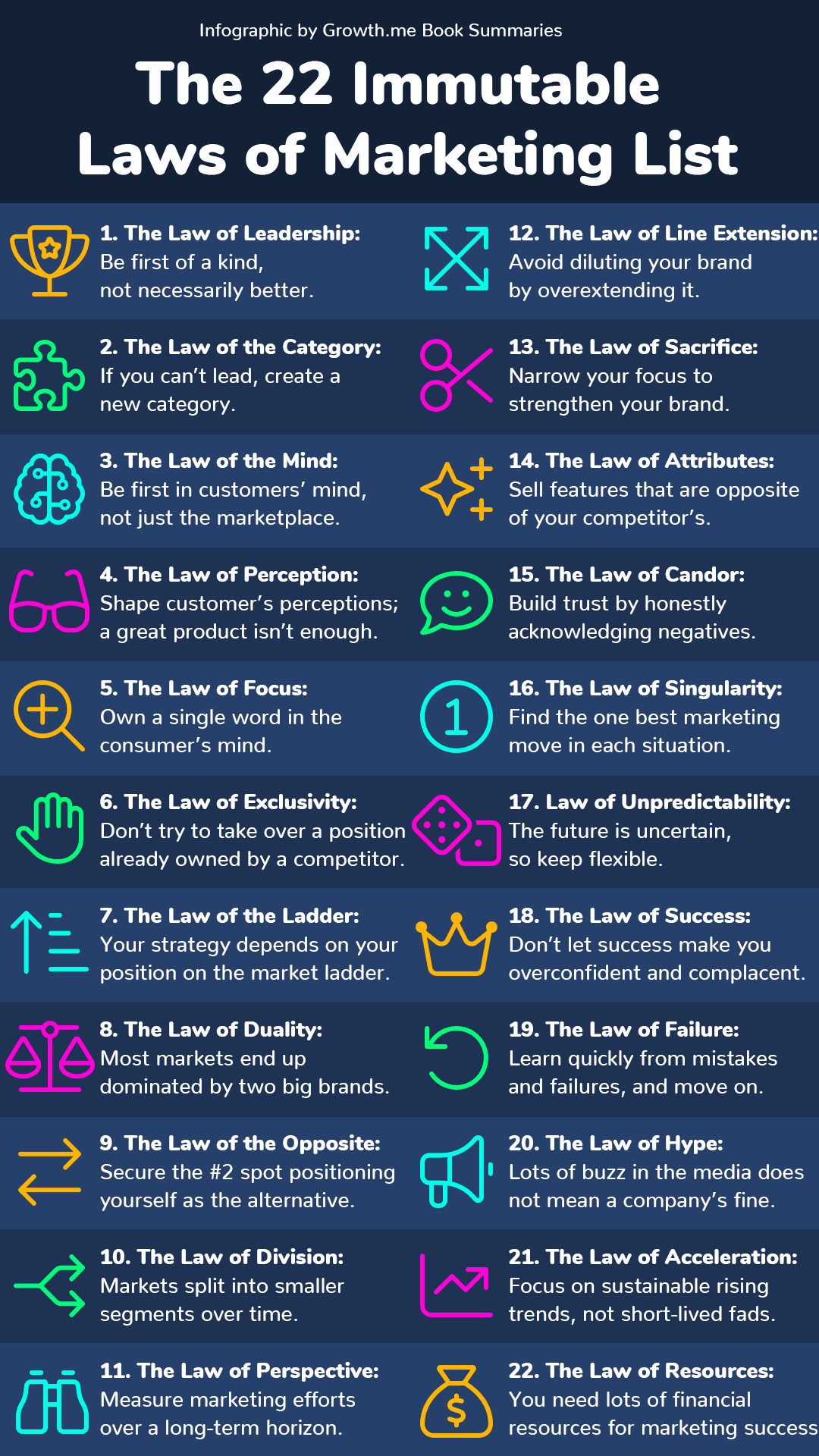
🔍 1. The Complete List: What are The 22 Immutable Laws of Marketing? (with examples)
Here’s a summary list of The 22 Immutable Laws of Marketing, including simple explanations and real-world examples:
- The Law of Leadership:
Be first, not necessarily better.
Example: Coca-Cola was the first cola and still leads the market. - The Law of the Category:
If you can’t lead, create a new category.
Example: Red Bull created the energy drink category. - The Law of the Mind:
Be first in customers’ mind, not just the marketplace.
Example: Gatorade is known as the first sports drink, but earlier ones existed. - The Law of Perception:
Shape your customer’s perception of you; product excellence alone doesn’t win.
Example: Most perceive Coke to taste better, but blind tests prove they actually prefer Pepsi. - The Law of Focus:
Own a single word in the consumer’s mind.
Example: Google owns “search.” - The Law of Exclusivity:
Don’t try to take over a position already dominated by a competitor.
Example: The Sony PlayStation offered serious 3d video games, rather than competing against Nintendo in family fun. - The Law of the Ladder:
Each market has a ladder of brands, your strategy depends on your market rank.
Example: Avis began making money only after acknowledging their position in the market: “We’re No. 2, so we try harder.” - The Law of Duality:
Most markets end up dominated by two major brands.
Example: The toothpaste market was split between Colgate and Crest. - The Law of the Opposite:
In well-established markets, secure the #2 spot by positioning yourself in contrast to the leader.
Example: Coke has classic appeal, so Pepsi positioned themselves towards the new generation. - The Law of Division:
Markets split into smaller segments over time.
Example: The car market split into dozens of different shapes and sizes including: sedans, hatchbacks, SUVs, trucks, minivans, etc. - The Law of Perspective:
Measure the impact of marketing efforts over a long-term horizon.
Example: Nike’s celebrity endorsements. - The Law of Line Extension:
Avoid weakening your brand by overextending into unrelated kinds of products.
Example: Coca-cola tried to sell clothing; the side business crashed after 2 years. - The Law of Sacrifice:
Narrow your focus to strengthen your brand’s presence.
Example: Steve Jobs reduced Apple’s product line to just 4 types of computers, cutting dozens of confusing variations. - The Law of Attributes:
Sell features and attributes of your product that are opposite of your competitors.
Example: Listerine focused on the health benefits of mouthwash, so Scope sold their better taste. - The Law of Candor:
Build trust by honestly acknowledging a downside of your product.
Example: Listerine counter-attacked Scope by admitting their mouthwash tastes bad, but claiming it is a demonstration of product effectiveness. - The Law of Singularity:
Find the one best marketing move in each situation.
Example: Ford recently decided to stop making small cars, doubling down on its strength in trucks and SUVs. - The Law of Unpredictability:
The future is uncertain, so keep your organization flexible.
Example: Kodak’s failure to adapt to digital photography. - The Law of Success:
Don’t let success make you overconfident and complacent.
Example: Nokia’s decline in the smartphone era. - The Law of Failure:
Learn quickly from mistakes and failures, rather than trying to avoid them.
Example: Domino’s improving their pizza recipe after negative customer feedback. - The Law of Hype:
A company may receive lots of buzz in the media, yet in reality be failing.
Example: The Segway received massive media coverage, but limited market impact afterwards. - The Law of Acceleration:
Focus on sustainable rising trends, not short-lived fads.
Example: The consistent growth of organic food products, compared to many fad diets that are quickly forgotten. - The Law of Resources:
You need substantial financial resources for marketing success.
Example: Apple’s spends up to $10 billion each year on advertising, despite existing brand recognition.
🥇 2. The Law of Leadership: Becoming the leader of a market category is more about being first, not better
Almost all people in business believe in one myth; the myth of the superior product.
From the smallest local coffee shop owner to the biggest corporate CEO, they all believe they can win through offering a better quality product than their competitors. It’s a belief captured in the old expression, “Build a better mousetrap and the world will beat a path to your door.” It’s just common sense!… isn’t it?
In The 22 Immutable Laws of Marketing, authors Al Ries and Jack Trout deconstruct this myth. After studying hundreds of number one companies, they have come up with the most important rule in this book…
The Law of Leadership is “be first, not better.” To have the leading brand or product in a category, you don’t need the best product. You often just need to get into people’s minds first.
For example, what is the first brand that comes into your mind, if someone asked you to name a university, a razor company, and an imported beer? For most, it would be the following:
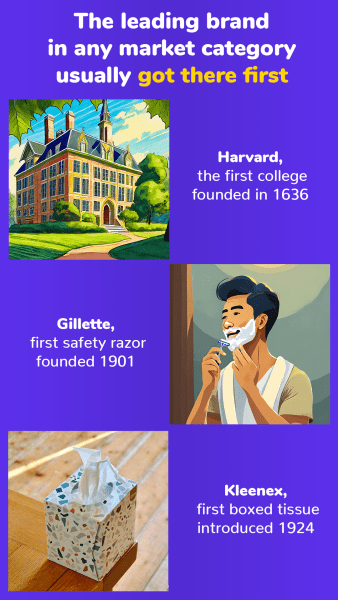
- Harvard is the leading college in America. It was also the first college in America.
- Gillette is the leading razor company, and also the first to sell safety razors.
- Heineken was the leading imported beer (when this book published), and also the first one.
In business, this has been called “first mover advantage.” It’s the idea that being first to market often gives a company an unshakeable foothold to become the leader. Here are a couple of reasons for it:
- A strong mental connection forms between a product category and the first major brand in that category. For example, people in many parts of the world use the words “Kleenex” and “tissue” interchangeably. As in, “Could you pass me a Kleenex?” Kleenex was the first facial tissue, introduced in 1924. And with that strong of a mental association, is it any wonder they continue to be number one?
- People will often perceive that first brand name in any category to be superior, regardless of whether better products come along later. In the Cola market, Coca Cola continues to be the leader, even though blind taste tests proved people actually prefer the taste of Pepsi. Even “New Coke,” a new formula created by Coca Cola themselves, was a complete failure despite over 200,000 taste tests showing it tastes better.
Peter Thiel is a billionaire tech entrepreneur, who was Elon Musk’s early business partner when they built PayPal together. He was also an early investor in world-changing startups like Facebook.
In his fascinating book Zero to One, Peter Thiel advises entrepreneurs to “avoid competition as much as possible,” echoing the advice from this book. He also said, “The perfect target market for a startup is a small group of particular people concentrated together and served by few or no competitors.”
Don’t try to make a better product. Instead, figure out how you can be the first in a market category. Being first imprints your brand in people’s minds as being superior. Just like Coca Cola, Kleenex, and Harvard.
✨ 3. The Law of the Category: It’s better to create a new product category, than to fight an existing leader
If you ask people who was first to cross the Atlantic Ocean by plane, many would know it was Charles Lindberg.
If you ask them who was second to cross it, almost nobody would be able to tell you. This is the law of leadership in action. But there’s a twist!
If you ask people who was the first woman to cross the Atlantic Ocean, many would say it’s Amelia Earhart. Because she was also the first, in a more narrow category.
This is the Law of Category: It’s all about creating something NEW. When you can’t be the first, find a new sub-category that you can be first in.
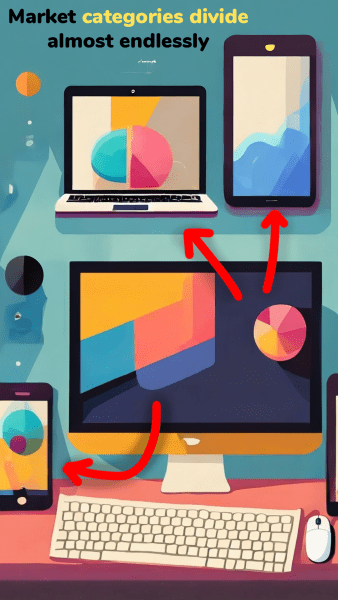
In markets with existing leaders, it’s better to create a new market space free of direct competition. For example, IBM was the leader in selling computers, and everyone thought they were untouchable, but then Dell came along and was first in selling computers by phone, eventually becoming a $900 million giant, too. Phone sales was the new category within the larger market of computers.
How can you be first in a new category? There are 3 major ways:
- Audience. You can be first to serve a unique audience. A great example is Lululemon, a company that “more or less invented an apparel category, athleisure,” according to Bloomberg. As a result, they became the most profitable company in a crowded space, making the founder worth $7 billion.
- Benefit. You can be first to provide a unique benefit. Apple was not the first computer, but they were first to market with a graphical user interface that made using the computer easy and intuitive. (A feature that Steve Jobs actually copied from researchers at Xerox.)
- Service. You can be first to offer a unique service. In a packed shipping market, FedEx was first to guarantee overnight shipping, creating a multi-billion dollar company, well, almost overnight.
Closely related is #9: The Law of Division. All markets eventually split into smaller segments over time. Just like the computer market split into personal computers, laptops, tablets, etc. And even within laptops, there are laptops for students, laptops for gamers, laptops for business, laptops for graphic design, etc.
Another related rule is #21: The Law of Acceleration. When you’re choosing a category or sub-category, make sure it’s not a short-lived fad, but a sustainable growing trend. This way, your business will be built upon a firm foundation.
Another landmark marketing book is Blue Ocean Strategy. That book advises business owners to avoid jumping into “red oceans” full of cutthroat competition, instead swim to “blue oceans” that are free of direct competitors.
They say: “… Instead of focusing on beating the competition, you focus on making the competition irrelevant by creating a leap in value for buyers and your company, thereby opening up new and uncontested market space.”
In a nutshell, the Law of the Category teaches us: Aim to be first in a NEW, growing category or sub-category. You can be first with a unique audience, benefit, or service. That’s where the real magic happens
👁️ 4. The Laws of Mind & Perception: In marketing, perception is reality, so it’s most important to get into people’s minds first
In marketing, what people perceive becomes their reality. So the laws of marketing apply most of all to being first in the mind of your customers, not just the marketplace. Which brings us to two of the most fascinating laws of marketing—the Law of Mind and the Law of Perception.
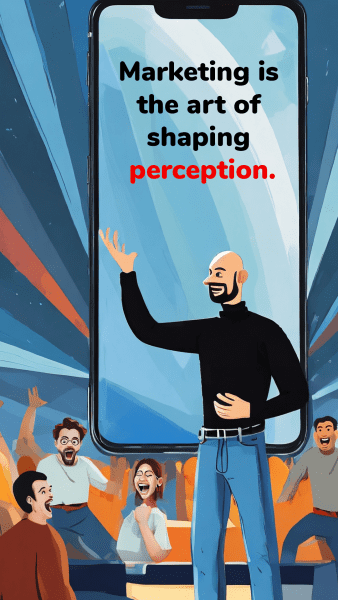
#3 The Law of Mind says you need to be first in the customer’s mind, not just the marketplace. You can have the most innovative product, but if people don’t hear about it, then a competitor can take the position anyway.
Ask most people to name the first real smartphone, and they will probably say iPhone. It wasn’t the first touchscreen smartphone, but it made a far bigger first impression than any other ones, so it stuck in people’s minds. When it comes to marketing, make a bold first impression, because trying to change people’s minds is useless.
This is why timing is so important in business. The 22 Immutable Laws of Marketing says it’s usually better to be early with your product, so you’re the leader as the market grows around you. But being too early is also possible, like with the earliest smartphones.
#4 The Law of Perception says that people’s perception matters more than your product itself. That doesn’t mean we can get away with selling a bad product, but that a good quality product alone is often not enough. We need to engage in marketing—shaping our customer’s perception of our brand.
As an example, Honda is the #1 car maker in America, but only #3 in Japan, where they are from. How can that be? These authors say it’s because they got into the minds of people in Japan first as a motorcycle company. Once that first impression had been set, it was hard to change, because most people feel reluctant to buy their car from a motorcycle brand.
Seth Godin, the highly popular marketing book author, wrote a book called Purple Cow about why products need to be different and stand out, like a single purple cow in a field of black-and-white ones. This is a powerful way to create a new first impression in people’s minds.
Seth Godin wrote, “in a crowded marketplace, fitting in is failing. In a busy marketplace, not standing out is the same as being invisible.”
Read more in Purple Cow by Seth Godin (our summary coming soon!)
To sum it up, make a bold first impression that counts. That’s the most effective way to cement the position of your brand in the minds of your customers. Perception often trumps the first actual product in a category.
💡 5. The Law of Focus: The power of narrowing your focus; owning one word in the customer’s mind
Many ineffective business owners believe that marketing is about trying to appeal to more people. But experts like Al Ries and Jack Trout say it’s exactly the opposite—marketing is all about narrowing your focus and reducing your target, because by standing for something you can truly speak to a certain type of customer.
That brings us to #5: The Law of Focus — that can be summed up as owning ONE word in the customer’s mind. Just like Google owns the word “search.” It’s the ultimate form of the marketing concept of narrowing your focus.

Your one word should be:
- Simple, common, and benefit-oriented. When it comes to cars, what’s the first brand that you associate with “reliability”? Probably Toyota. Likewise for “safety” it’s Volvo and for “luxury” it is probably Mercedes Benz. All these companies own one word in their customer’s minds, an everyday word that speaks to a benefit.
- Not multiple words, but just one. It can be painful to decide on one primary word, but trying to own multiple words never ends up working. There’s always sacrifice involved. For example, Walmart owns the term “low prices” and even their first store had “we sell for less” on the store sign. But the founder Sam Walton even admits those early Walmart stores did not look good at all. They picked one singular focus, and that meant sacrificing other things.
- Not generic like “quality.” Avoid boring generalities that don’t really say anything, like “we offer the highest quality service.” For your one word to be real, someone must be willing to stand for the opposite position. No company will say they offer poor quality service. But in the automotive market, the opposite of a safe or reliable car would be a fast and exciting car—partly the reason why Ford decided to use a different brand called Mustang for their sports car.
- Must be unclaimed. This is related to #6: The Law of Exclusivity. If another brand already owns a word, don’t try to take it. Your word must be unclaimed, especially if you’re not the leader. To illustrate why, take this example: when General Motors advertises their cars are safe, that makes consumers think about safety, which makes them think of Volvo. A much more effective approach was taken by Subaru, who are well known for their all-wheel-drive system that provides traction in snow and mud. This makes them basically own the “winter safety” subcategory, and as a result Subaru is popular in northern climates.
Let’s look at an even more modern example. When you think of “electric cars,” what brand comes to mind? Tesla, no doubt. Within the ultra-competitive car market, Tesla managed to find an unclaimed position, so they now reliably sell one of the top 10 most popular cars in the US.
But if you read the biography of Elon Musk, you’ll see this is just the beginning. How did Tesla succeed when many other electric car attempts had failed, including by huge automakers? By starting with an even more narrow focus. With their first mainstream car the Model S, they positioned the car as a status symbol for a specific type of wealthy, eco-conscious buyer—instead of a dorky science experiment as previous electric cars had looked.
The bottom line is, in the crowded marketplace, owning a single, powerful word can make all the difference. Keep it simple, tangible, and unique—and watch your brand soar.
🥈 6. The Law of the Opposite: The power of branding yourself as the underdog; the alternative choice to the leader
Who says you need to be number one to win? Pepsi, Burger King, and Target all prove you can be ultra-successful as number two.

#9: The Law of the Opposite says when there’s a strong leader, you can take the lucrative number two spot not by trying to beat them, but by positioning yourself as a distinct alternative. It’s all about the art of contrast. If the market leader is “the real thing” like Coke, we can brand ourselves “the new generation” like Pepsi did.
Some related laws:
- #8: The Law of Duality. Most markets are eventually dominated by two major brands. One is reliable and time-tested; the second is the challenger. Many people are compelled to choose the underdog, the upstart, the challenger. It’s one reason we root for Luke Skywalker against the Empire.
When Apple began selling computers, they branded the market leader IBM as “big blue,” a soulless monolithic corporation. They communicated that Apple was for those who “think different” and don’t conform to what everyone else is doing. (A marketing strategy that, somewhat ironically, made Apple the most valuable company on the stock market, worth about $3 TRILLION!) - #14: The Law of Attributes. Look at the leading brand’s main benefit. You can usually find the opposite and sell that. For example, McDonald’s owned the benefit “fast,” so Wendy’s chose “fresh, never frozen.” Listerine mouthwash owned “cavity prevention,” so Scope chose “good taste.” Nintendo owned family video games, so PlayStation chose 3d games for teenagers and grown-ups.
- #7: The Law of the Ladder. Each market has a ladder of brands. An effective marketing strategy is to acknowledge your position on the ladders. Hertz is number one in car rentals, so Avis went with the campaign: “We’re number two, so we try harder.” (Also ties into #15: The Law of Candor—by acknowledging a negative in your product you win trust.)
In short, being number two isn’t always a disadvantage. It can be an opportunity to position yourself as the clear, differentiated alternative. The preferred choice for those who don’t follow the crowd.
↔️ 7. The Law of Line Extension: The danger of stretching your brand name too thin
Imagine stretching a rubber band too far – it loses its shape or even snaps. That’s exactly what happens when we try stretching our brand too far.

#12: The Law of Line Extension warns about the risks of using an established brand name on new, unrelated products. It seems like a quick win, but tends to result in long-term pain. Diversifying too much makes us lose focus on what made the business successful.
Take 7UP, for example, which became popular branding itself as the “Uncola.” Then they began rolling out countless new flavours, which didn’t lead to a long-term sales increase because they diluted what 7UP stood for.
Toyota provides a masterclass in how to do it right. When they wanted to enter the luxury car market, they didn’t extend the Toyota brand. Instead, they created Lexus, a new brand that quickly became synonymous with luxury.
Related is #13: The Law of Sacrifice, which says that success in marketing requires giving something up. When Steve Jobs returned as CEO of Apple after an extended absence, he discovered the company’s product line had become bloated and confusing. So he drastically cut the number of computer models they sold, knowing they could actually be more successful by selling less.
In a nutshell: stretching a brand too far can weaken. The 22 Immutable Laws of Marketing say: stay focused, be ready to sacrifice, and don’t be afraid to cut down your product line when necessary.
- What “first” can you be? Write down 5 ideas for what your brand or product can be the first in. This doesn’t necessarily mean being the first ever, but perhaps first to serve a specific audience or offer a certain feature or service.
- Simplify your brand message. Choose one key word or concept you want your brand to own in customer’s minds. This word should be simple, benefit-oriented, and unclaimed by your direct competitors.
- Focus on perception, not only product. How do you want your product to be perceived by your customers? What do you want them to associate it with—whether famous people, core values, or primary benefits. Focus on that in your communications, because in marketing perception is reality.
- Position as an alternative. If you’re not the market leader, you can position yourself as a distinctive alternative. Choose the leader’s primary appeal, then avoid competing directly with that, instead offer something different. Be the rebel or the specialist.
- Avoid overextending your brand. Resist the temptation to apply a successful brand name to a wide range of products. Focus on maintaining strength and clarity in your core business area.


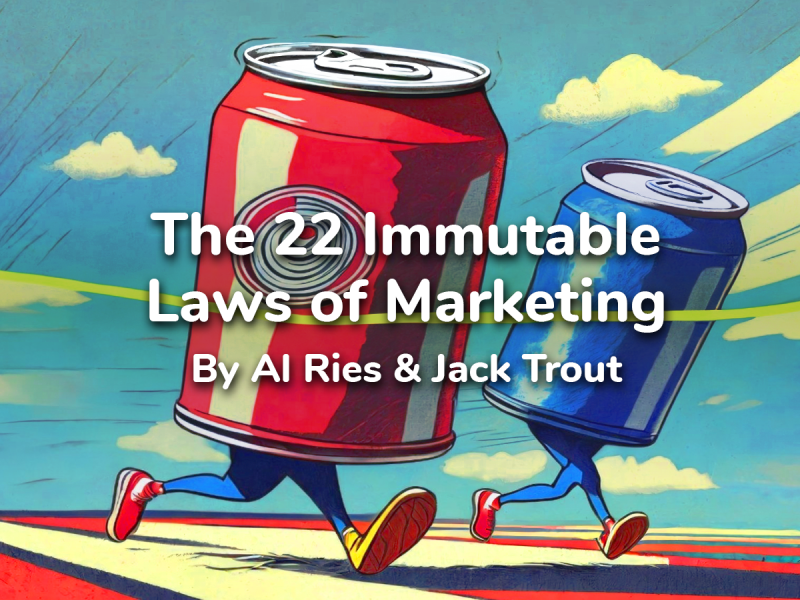
















Community Notes